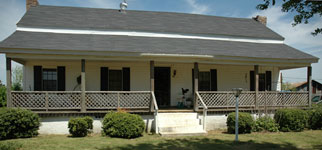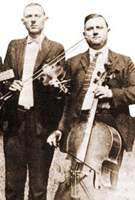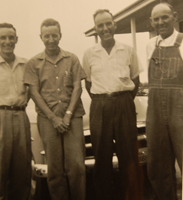Bio:
Staying in the traces
When Lee Stripling was rediscovered by modern fiddlers in Seattle in the 1980s, “authentic” became the refrain.

The Stripling family, about 1933: Lee,
Robert, Charlie, Tellie, Vaudeen, Elsie,
little Clarence and Christine.
Lee learned fiddle in the 1920s and ’30s from his famous father, Charlie Stripling, during summer “lay bys” – a time set aside to let the cotton grow in the hot Alabama sun. Today, at 85, he still has the driving “Stripling sound” described by music historian Joyce Cauthen as “the big deep tone and sliding notes that roll out of the fiddle.”
Since resuming as a professional musician in 2000 – after a gap of 60 years – Lee leaves his audiences smiling and with toes tapped out at dances, cafes, retirement homes and major music festivals such as Northwest Folk Life and the Festival of American Fiddle Tunes.

The Stripling place, 2006. Neighbors
overflowed the porch when the family played.
He’s best known for his fiddle, particularly his dad’s tunes, but audiences often request Western swing, cowboy and Tin Pan Alley songs, where Lee’s innate joy, perfect rhythm and true voice come alive.
Like the mules in their guiding traces that Lee Edwin Stripling drove as a boy in the cotton fields, his music is yoked to rural roots. His history parallels the first 50 years of Country Western music and the uplifting beat of Western swing.

Brothers Charlie and
Ira Stripling recorded
42 sides between 1928
and 1936.
Lee’s father, Charlie Melvin Stripling (1896-1966), learned to play fiddle at age 18 after picking out tunes on a toy fiddle he bought for a nephew for Christmas. In less than a year, “Mr. Charlie” Stripling was striking tunes on a real fiddle and winning local contests, accompanied by his brother Ira on guitar.
In the 1920s, radio brought the comfort of rural string music into homes across the country through “barn dance” variety shows. To their great surprise, record-company executives found Southern fiddlers among the biggest sellers.
Early stars included the original Stripling Brothers, who recorded 42 sides – including original compositions – between 1928 and 1936, when music was a much-needed cash crop for Charlie Stripling, who was forced to move from shack to shack as a sharecropper after a relative defaulted on a loan.

Clarence, Lee, Robert
and Charlie on Lee’s visit
home, 1956.
Lee was 8 and his brother Robert nearly 10 when they took their first steps as the new Stripling Brothers in the late 1920s, after a railroad man left a Gibson guitar and mandolin behind. At age 13, less than a year after learning the fiddle, Lee won first place over his daddy in a fiddle contest judged by the roar of the audience.
Brother harmony acts the likes of the Delmore Brothers were gaining popularity. Lee and Robert added singing to their repertoire, entertaining with sweet harmonies they practiced on long days picking cotton in the red Alabama fields – songs they would resurrect as they toured Northwest Alabama and North Carolina on the “Stripling Brothers 2000” tour.

Lee enlisted in the
Army Air Corps
in 1942.
As hillbilly music gave way to the romance of the guitar-picking cowboy, Lee stepped back from the fiddle. He and Robert both formed bands in the Civilian Conservation Corps and later in World War II, playing more sophisticated Western swing.
Lee stopped playing professionally to raise a family after the war. The original Stripling Brothers music was reissued in the 1960s and, much to Lee’s surprise, the youthful musicians who started dropping by his Seattle home two decades later had memorized numbers such as “Lost Child,” “Kennedy Rag,” and “Wolves A’Howlin.”

Lucille, Carol, Sherry and Lee,
about 1962.
Inspired by finding the real thing, they encouraged Lee to sit in at small musical gatherings. When Lee’s wife Lucille died in 1998, the younger musicians pulled him from his grief. As it had in the Great Depression, music again became his salvation.
Many musicians supported him, most notably Tony Mates, Glenn Dudley and Bonnie Zahnow, who all still play with him regularly, and Kerry Blech. But guitarist W.B. Reid, who’s in both The Lee Stripling Trio and Lee Stripling and His Six Footed Boys, did the most to help Lee cut his first CD in 2000 and elevate his pace and confidence back to a professional level.
Lee teamed with his brother Robert to teach at Fiddle Tunes in 2000 and take part in tours of Northwest Alabama in 2004 and 2006, where a few old timers remembered not only hearing “the boys,” now 86 and 88, but also Mr. Charlie.